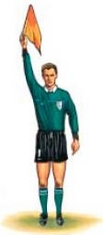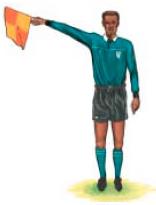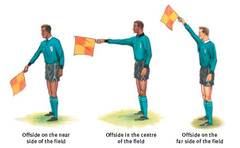- HOME
- MINDSET
- T-SHIRTS
- JUST4KEEPERS GOALKEEPER TRAINING
- UNDERSTANDING GOALKEEPING
- LAWS of SOCCER
- Law 1: The Playing Field (Pitch)
- Law 2: The Ball
- Law 3: The Number of Players
- Law 4: The Player's Equipment
- Law 5: The Referee
- Law 6: Assistant Referee
- Law 7: The Duration of the Match
- Law 8: The Start and Stop of Play
- Law 9: Ball in and out of Play
- Law 10: The Method of Scoring
- Law 11: The Offside
- Law 12: Fouls and Misconduct
- Law 13: Free Kicks
- Law 14: Penalty Kicks
- Law: The Throw In
- Law 16: The Goal Kick
- Law 17: The Corner Kick
- FIFA
- WOMEN'S SOCCER
- 2014 WORLD CUP
- 2010 WORLD CUP FINAL
- LIVE SCORES and LEAGUE STATISTICS
- BLOG
- USING UNDERSTANDING SOCCER
- MLS
- WNSL
- LEAGUE PLAY
- ANATOMY OF A GAME
- SOME BACKGROUND
- OFFENSE
- DEFENSE
- YOUTH SOCCER
- HISTORY OF SOCCER
- GEORGE VECSEY
- REGIONAL & INTERNATIONAL PLAY
- SOCCER TERMINOLOGY
- BOOKS / REFERENCES
- FEEDBACK / QUESTIONS
- SOME PERSPECTIVES
- PHOTO GALLARY
- FORUM
- BREAKAWAY VIDEO
- USA SOCCER
- JEN'S MOTH
Assistant Referee Signals
On the field, the assistant referee's job is simple: assist the referee. Whether by calling an offside or directing a throw-in, the referee relies on the assistant's input. It is just as important to understand the assistant as it is to understand the referee, so here's a crash course in basic flag-waving.
Watch for the Flag Up

This is the most basic signal the assistant will make. By putting the flag up, they are indicating to the referee that plays needs to be stopped for some reason. Typically, when the assistant sees something, they will put up the flag, and after the referee blows the whistle the assistant will indicate what they saw. If the referee does not see the flag, the other assistant will typically "mirror" the signal to help attract the referee's eye
Watch for Ball Out-of-Play and Restarts

One of the two main jobs of the assistant is to indicate when the ball is out of bounds and how the game should proceed. Once the referee has blown the whistle, the assistant will indicate how to proceed
Throw-In: If the assistant raises the flag, at a 45 degree angle, and points it horizontally along the touch line, they are indicating for a throw-in. The team attacking in the direction they are pointing takes the throw.
If the assistant stands near the goal line and points at the goal, they are signalling for a goal kick.
If the assistant stands near the goal line and points at a downward 45 degree angle toward the corner flag, they are signalling for a corner kick.
Throw-In: If the assistant raises the flag, at a 45 degree angle, and points it horizontally along the touch line, they are indicating for a throw-in. The team attacking in the direction they are pointing takes the throw.
If the assistant stands near the goal line and points at the goal, they are signalling for a goal kick.
If the assistant stands near the goal line and points at a downward 45 degree angle toward the corner flag, they are signalling for a corner kick.
Offside Signals

Watch for offsides. This is initially indicated by a flag straight up in the air, to indicate to the referee that play must be halted. When the referee's calls the offside with a whistle, the assistant then holds the flag in one of three positions in front of them to indicate where on the field the offside occurred and thus where the ball should be placed for the freekick. But if the referee gives you a waving gesture it means there was no advantage in play so it continues and you lower your flag.
If they hold the flag up at a 45 degree angle, they are signalling for an offside on the far side of the field (from them).
Signal for offside in middle of field If they hold the flag straight horizontally, they are signalling for an offside in the middle of the field.
If they hold the flag down at a 45 degree angle, they are signalling for an offside on the near side of the field.
If they hold the flag up at a 45 degree angle, they are signalling for an offside on the far side of the field (from them).
Signal for offside in middle of field If they hold the flag straight horizontally, they are signalling for an offside in the middle of the field.
If they hold the flag down at a 45 degree angle, they are signalling for an offside on the near side of the field.
Watch for Substitutions

If the assistant holds his flag above his head with both hands, he is indicating to the referee that a substitution is being performed and that play should not be started until it is finished.
Other Signals
Watch for the goal signal. When the assistant thinks a goal has been scored, they will lower the flag, optionally may point to center with their hand and sprint back to the center line. If they want to dispute the goal, however, they will put the flag up and stay where they are.
Watch for the penalty kick signal. This can vary from region to region. Generally, if a foul is called by the referee and it is inside the penalty area the AR will move toward the corner flag. If the AR stays where they are then it indicates the foul was outside the penalty area. The referee can then determine the appropriate restart. Other possible signals for penalty kicks include holding the flag horizontally across the chest or running to the corner flag and hiding their flag behind their back.
Watch for the miscellaneous signal. When the assistant simply keeps the flag straight up after the whistle is blown, he is indicating he needs to talk to the referee. The assistant may show this signal if, for example, a player begins abusing him or he sees outside interference. In particular, if he wishes to indicate that a player deserves a yellow or red card, he will place his hand over his chest badge.
The referee's signal always takes priority over the assistants.
A good assistant referee will always stay in line with the second to last defender or the ball, whichever is closer to the goal line, so as to make judging offside easier.
A quick explanation of the restarts that can be signalled for:
A goal kick is awarded when the ball travels over the goal line after last being touched by an attacker. A goal kick is taken from anywhere in the goal area by any defending player (including, obviously, the keeper) and is considered to be in play when it leaves the penalty area.
A corner kick is awarded when the ball travels over the goal line after last being touched by a defender. A corner kick is taken from anywhere in the corner arc by any attacking player and is considered to be in play when it is kicked and moves.
A throw-in is awarded when the ball travels over the touch (or side) lines to the opposing team of the team that touched it last. A throw-in must be thrown in a fluid motion over the players head and is in play when the ball leaves the player's hands.
One of the main responsibilities of the assistant is calling offside. To have an offside offense, one must have a player in an offside position who is involved in active play.
A player is in an offside position when he is in the opposing half closer to the goal line than the ball and the last defender (not including the goalkeeper)
A player is involved in active play when he touches, plays or attempts to play the ball, interferes with an opponent (such as screening the keeper), gains an advantage from being in the offside position.
There are no offsides directly from a goal kick, corner kick or throw in.
Watch for the penalty kick signal. This can vary from region to region. Generally, if a foul is called by the referee and it is inside the penalty area the AR will move toward the corner flag. If the AR stays where they are then it indicates the foul was outside the penalty area. The referee can then determine the appropriate restart. Other possible signals for penalty kicks include holding the flag horizontally across the chest or running to the corner flag and hiding their flag behind their back.
Watch for the miscellaneous signal. When the assistant simply keeps the flag straight up after the whistle is blown, he is indicating he needs to talk to the referee. The assistant may show this signal if, for example, a player begins abusing him or he sees outside interference. In particular, if he wishes to indicate that a player deserves a yellow or red card, he will place his hand over his chest badge.
The referee's signal always takes priority over the assistants.
A good assistant referee will always stay in line with the second to last defender or the ball, whichever is closer to the goal line, so as to make judging offside easier.
A quick explanation of the restarts that can be signalled for:
A goal kick is awarded when the ball travels over the goal line after last being touched by an attacker. A goal kick is taken from anywhere in the goal area by any defending player (including, obviously, the keeper) and is considered to be in play when it leaves the penalty area.
A corner kick is awarded when the ball travels over the goal line after last being touched by a defender. A corner kick is taken from anywhere in the corner arc by any attacking player and is considered to be in play when it is kicked and moves.
A throw-in is awarded when the ball travels over the touch (or side) lines to the opposing team of the team that touched it last. A throw-in must be thrown in a fluid motion over the players head and is in play when the ball leaves the player's hands.
One of the main responsibilities of the assistant is calling offside. To have an offside offense, one must have a player in an offside position who is involved in active play.
A player is in an offside position when he is in the opposing half closer to the goal line than the ball and the last defender (not including the goalkeeper)
A player is involved in active play when he touches, plays or attempts to play the ball, interferes with an opponent (such as screening the keeper), gains an advantage from being in the offside position.
There are no offsides directly from a goal kick, corner kick or throw in.
Copyright protected 2013 Alan Rubin all rights reserved